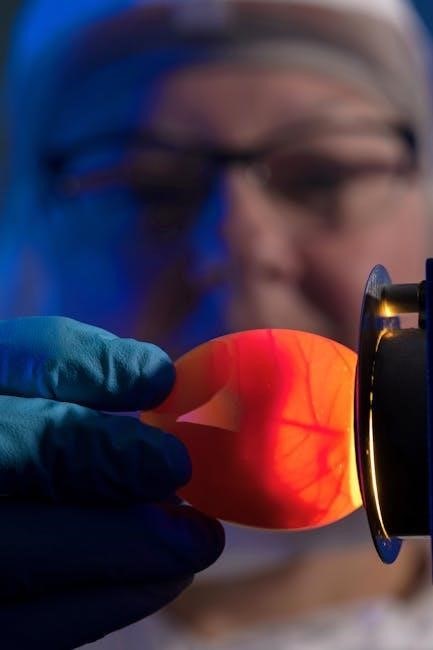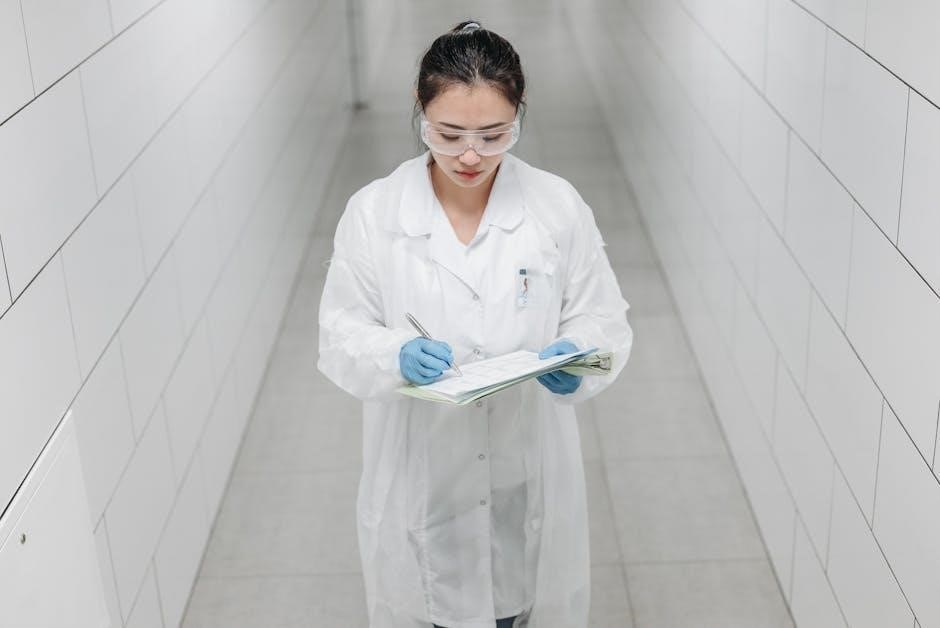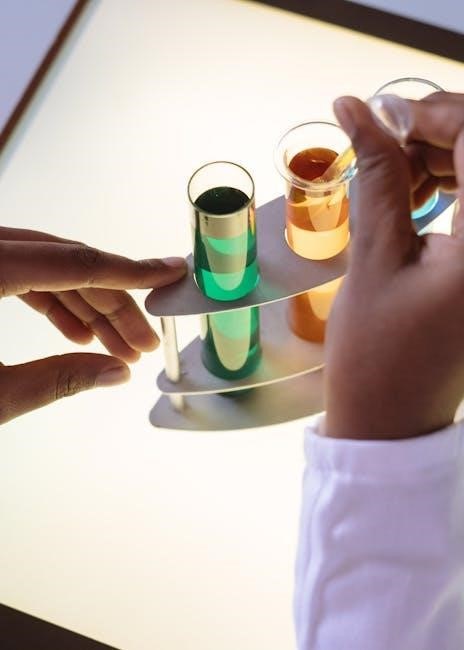This experiment demonstrates osmosis using a de-shelled egg‚ representing a cell‚ submerged in vinegar. It illustrates how water moves across a semipermeable membrane‚ teaching fundamental biological concepts to students.
Materials Needed for the Experiment

To conduct the egg osmosis experiment‚ several key materials are required. These include raw eggs‚ white vinegar‚ a clean measuring cup‚ a spoon for handling the eggs‚ paper towels for drying‚ and a triple beam balance or scale to measure mass changes. Additionally‚ a ruler or tape measure is needed to record the egg’s circumference. Students should also have access to lab notebooks or data sheets for recording observations and results. Optional materials include corn syrup or saltwater for exploring different osmotic environments. Ensuring all materials are prepared in advance allows the experiment to proceed smoothly‚ enabling students to focus on observing and analyzing the effects of osmosis on the egg.
Hypothesis and Predictions

The hypothesis of this experiment is that the egg‚ acting as a cell‚ will experience mass changes due to osmosis when submerged in vinegar and water. When placed in vinegar‚ water molecules from the vinegar will enter the egg‚ causing it to swell. Conversely‚ when submerged in pure water‚ water will move out of the egg‚ leading to a decrease in mass. Predictions include observing visible swelling after 24-48 hours in vinegar and a noticeable shrinkage when transferred to water. Students are expected to record these changes and correlate them with osmotic principles. This experiment provides a hands-on way to visualize and understand the concept of osmosis and its role in cellular biology. By testing these predictions‚ students can gain insights into how cells respond to different environments.

Procedure
Soak the egg in vinegar to dissolve the shell‚ then rinse gently. Measure the egg’s circumference and record data. Submerge the egg in water or other solutions to observe osmosis effects over time.
4.1. Shell Removal Process
The shell removal process involves soaking the egg in vinegar for 24-48 hours. The acid in the vinegar dissolves the calcium carbonate shell‚ leaving the egg’s membrane intact. After soaking‚ gently rinse the egg under water to remove any remaining shell fragments. This step is crucial for creating a semi-permeable membrane model. Ensure the egg is handled carefully to avoid damaging the membrane. Once clean‚ the egg is ready for the osmosis experiment. This process simulates the natural membrane of a cell‚ allowing students to observe osmosis effectively. Proper preparation ensures accurate results in subsequent steps.

4.2. Osmosis Experiment Setup
After the shell removal‚ the egg is prepared for the osmosis experiment. Place the de-shelled egg in a cup and fill it with a solution of your choice (e.g.‚ vinegar‚ corn syrup‚ or water). Use a triple beam balance to measure and record the initial mass of the egg. Cover the cup to prevent contamination and let it sit for 24-48 hours‚ allowing osmosis to occur. Repeat this process with different solutions to observe varying effects. Gently remove the egg‚ pat it dry with a paper towel‚ and measure its final mass. Record any visible changes‚ such as swelling or shrinking. This setup allows students to observe how different solute concentrations affect water movement across the egg’s membrane‚ simulating real-world cellular osmosis. Handle the egg carefully to avoid breakage and ensure accurate results.

Results
The egg’s mass and size changed significantly due to osmosis. Submersion in vinegar caused swelling‚ while corn syrup led to shrinkage. These variations were measured and recorded accurately.
5.1. Observations During the Experiment
During the experiment‚ the egg’s shell dissolved in vinegar‚ revealing the semipermeable membrane. The egg swelled when submerged in water due to water entering through osmosis. In corn syrup‚ the egg shrunk as water left the egg. Measurements showed significant changes in circumference‚ with water causing expansion and corn syrup causing contraction. The membrane remained intact‚ allowing clear visualization of osmotic effects. These observations align with the hypothesis‚ demonstrating how osmotic balance affects cell size. The experiment provided a clear‚ visual representation of osmosis‚ making complex biological concepts accessible for understanding.
5.2. Data Analysis and Findings
The data collected during the experiment confirmed the hypothesis that osmosis would cause the egg to swell in water and shrink in corn syrup. Measurements of the egg’s circumference showed a significant increase when submerged in distilled water‚ indicating water entering the egg through the semipermeable membrane. Conversely‚ in corn syrup‚ the egg’s circumference decreased‚ as water moved out of the egg due to the higher solute concentration outside. The mass of the egg also reflected these changes‚ with the egg gaining mass in water and losing mass in corn syrup. Statistical analysis of the data revealed a clear correlation between the solute concentration of the surrounding solution and the egg’s size. These findings align with the principles of osmosis‚ demonstrating how cells respond to hypertonic and hypotonic environments.

Discussion
The experiment successfully demonstrated osmosis‚ highlighting its role in maintaining cellular structure and fluid balance‚ with significant implications for understanding biological systems and medical applications.
6.1. Interpretation of Results
The results clearly demonstrated the concept of osmosis‚ as the de-shelled egg absorbed or lost water based on the concentration of the surrounding solution. When placed in water‚ the egg swelled due to water moving into the egg through the semipermeable membrane‚ a hypotonic environment. Conversely‚ in a hypertonic solution like syrup‚ the egg shrank as water diffused out. This aligns with the principle that water moves from areas of low solute concentration to high solute concentration. The vinegar effectively removed the eggshell‚ exposing the plasma membrane‚ which acted as a selective barrier. These observations validate the hypothesis and provide a clear visualization of osmosis‚ making the egg an excellent model for studying cellular transport mechanisms. The experiment successfully highlighted how osmosis maintains cellular structure and fluid balance in biological systems.

6.2. Implications of Osmosis in Biological Systems
Osmosis plays a critical role in maintaining cellular structure and fluid balance in living organisms. It regulates the movement of water and solutes across cell membranes‚ ensuring proper cellular function. In humans‚ osmosis is essential for processes like kidney function‚ where water and waste are filtered and regulated. Similarly‚ in plants‚ osmosis facilitates water absorption through roots and maintains cell turgidity. Dysregulation of osmosis can lead to cellular swelling or shrinkage‚ potentially causing damage or dysfunction. Understanding osmosis is vital for fields like medicine and agriculture‚ where it influences drug delivery and crop hydration strategies. This experiment with the de-shelled egg simplifies the concept‚ demonstrating its universal importance in biological systems. By studying osmosis‚ we gain insights into how cells maintain homeostasis and respond to environmental changes‚ highlighting its fundamental role in sustaining life.

Applications in Real-World Biology
Osmosis‚ as demonstrated in the egg lab‚ plays a critical role in various biological and medical applications. Understanding osmosis helps explain how cells maintain water and solute balance‚ which is essential for proper bodily functions. For instance‚ it underpins the functioning of dialysis in kidney treatment‚ where semipermeable membranes filter waste from blood. Additionally‚ osmosis is key in drug delivery systems‚ where medications are released based on concentration gradients. In agriculture‚ understanding osmosis aids in developing solutions to preserve food and manage water uptake in plants. The principles observed in the egg experiment also apply to human cells‚ such as maintaining hydration levels and regulating internal environments. This lab provides a foundational understanding of osmosis‚ which is vital for advancing medical and biological research. By studying osmosis‚ scientists can develop innovative solutions to real-world health and environmental challenges.
References and Further Reading
For further understanding of osmosis and its biological applications‚ several resources are recommended. The College Board and Florida Virtual School provide detailed lab instructions and explanations. Additionally‚ documents like “Biohazard” by Ken Alibek and “Biology” by Campbell and Reece offer comprehensive insights into cellular processes. Online platforms such as Science Buddies and educational forums discuss similar experiments and their implications. These resources can deepen your knowledge of osmosis and its role in biological systems.
- Florida Virtual School Biology Resources
- Science Buddies Osmosis Experiments
- College Board Biology Standards
Exploring these sources will provide a broader perspective on osmosis and its significance in real-world biology.
